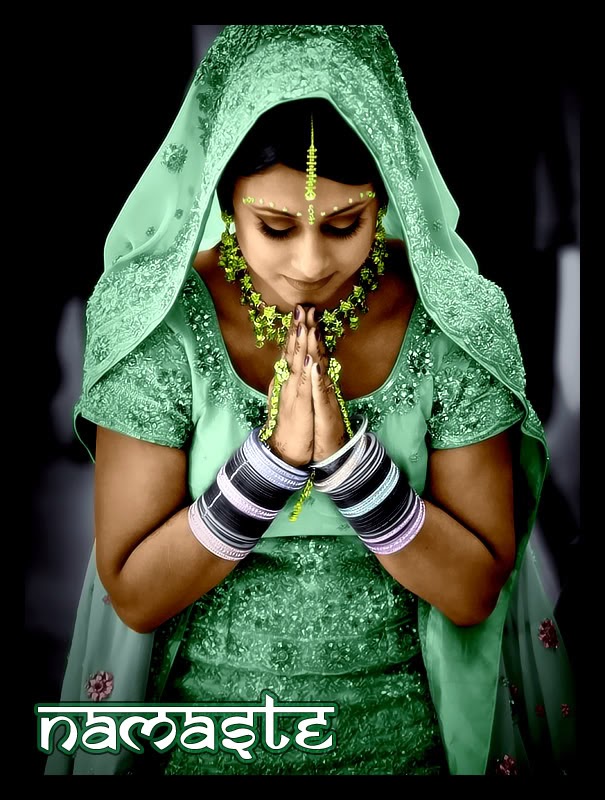Namaste According to the Scriptures
Namaste and its common variants ‘namaskar,’ ‘namaskaara’ or ‘namaskaram’, is one of the five forms of formal traditional greeting mentioned in the Vedas. This is normally understood as prostration but it actually refers to paying homage or showing respect to one another, as is the practice today, when we greet each other.
The Meaning of Namaste
In Sanskrit (Devnagiri script) the word is namah + te = namaste which means “I bow to you” - my greetings, salutations or prostration to you. The word ‘namaha’ can also be literally interpreted as "na ma" (not mine). It has a spiritual significance of negating or reducing one's ego in the presence of another.
Vedic way to do Namaste
When meeting someone, do Namaskar by bending the arms from the elbow upwards and joining the fingers and placing tips of the thumbs on the Anahat chakra (at the centre of the chest). Place the two palms together and keep the folded palms in front of the chest. Utter the word 'namaste' and while saying the word, you must have a smile on your face and you also must bow down your head slightly.
The gesture is often accompanied by words like "Ram Ram,” "Jai Shri Krishna", "Namo Narayana", "Jai Siya Ram", "Om Shanti" etc - indicating the recognition of this divinity.
The Traditional explanation of Namaste
Namaste or namaskar is used as a respectful form of greeting, acknowledging and welcoming a relative, guest or stranger. It is used with good byes as well. In some contexts, namaste is used by one person to express gratitude for assistance offered or given, and to thank the other person's for his or her generous kindness. It is an acknowledgement and appreciation of the fact that there is a God in all of us and we must respect that.
The real meeting between people is the meeting of their minds. When we greet another, we do so with namaste, which means, "may our minds meet,"
Namaskar is also part of the 16 upacharas used inside temples or any place of formal Puja (worship). Namaste in the context of deity worship, conclude scholars, has the same function as one in greeting a guest or anyone else. It expresses politeness, courtesy, honor, and hospitality from one person to the other. This is sometimes expressed, in ancient Hindu scriptures such as Taittiriya Upanishad, as Atithi Devo Bhav (literally, the guest is god).
Namaste is one of the six forms of pranama, and in parts of India these terms are used synonymously.
The Scientific explanation of Namaste
Aura transfer:
Namaskar increases the spiritual emotion of humility in the embodied soul. Sattva frequencies from the universe are attracted by the fingers (which act as an antenna) and are then transmitted to the entire body through the thumbs which have awakened the Anahat chakra. This activates the soul energy of the embodied soul. In addition, by doing Namaskar in this manner to each other, frequencies of blessings are also transmitted.
Exercise:
Joining both hands ensures joining the tips of all the fingers together; which are denoted to the pressure points of eyes, ears, and mind. Pressing them together is said to activate the pressure points which helps us remember that person for a long time. It also reduces stress; helps to focus; increases the flexibility of the hands, wrist and the fingers; can improve the concentration and can help to increase the influence of meditation on the mind and body of the person.
In today's world, people are addicted to computer and mobile, Due to long use of this, there wrist and palm starting paining. On consultation, may physiotherapist has suggest them to do one of the exercise that is similar to Namaste gesture (without words).
Ego:
As the word Namaste itself explains. When one has already said and feel 'I blow to you', he/she has already reduced one's ego in front of another.
Health:
No germs since we don’t make any physical contact!
It is believe that will doing hand shake. It is, indeed, a more hygienic, non-aggressive, and graceful way of greeting than the Western custom of shaking hands or hugging.
Handshake transfers undesirable raja-tama components!
In short, in a handshake, the raja-tama components in one person may get transferred to the other person, thereby lowering his sattvikta (Purity levels). While practising Spirituality, our objective is to perform acts which increase our sattvikta.
An Appeal To You
In today's world, where western influence is more on us (Indian's) and our children's. Where we have started greeting by doing hand-shake, hug or kiss on the person's chick. Not for our culture, but at least for our health, let us follow and greet by doing Namaste.
Contains and Image Courtesy:
http://hinduism.about.com/od/artculture/p/namaste.htm
http://www.metaphysics-knowledge.com/customstraditions/the-essence-of-namaste.html/
https://www.boddunan.com/articles/people-places/59-customs-and-culture/13416-indian-customs-vs-scientific-reasons.html
http://en.wikipedia.org/wiki/Namaste
http://www.hindujagruti.org/hinduism/knowledge/article/why-namaskar-and-not-a-hand-shake.html











